
This page last modified: 28 December, 2002

The surviving copies of the Notitia Dignitatum, the "List of Offices" or better, the "Register of Dignitaries" (but see here), illustrate patterns for a large number of Roman military units dating to approximately 400 AD. These differ radically in style from those depicted on monuments dating to the early days of the Roman Principate and doubt has even been cast upon their authenticity, some going so far as to claim they the invention of the medieval scribes who transcribed them.
The Piazza-Armerina mosaics show that there is nothing improbable about the Notitia designs. These delightful illustrations from Sicily are dated to the early 4th century AD (the period of the "Tetrarchy"), less than 100 years before the Notitia was drawn up. Included in the scenes are depictions of men, apparently soldiers, hunting wild beasts such as elephants and lions, these no doubt being destined for the circus. As can be seen in the two photos below, the shield pattern styles depicted in these mosaics are just like those shown in the Notitia.
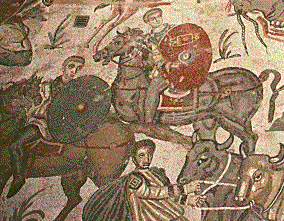
|
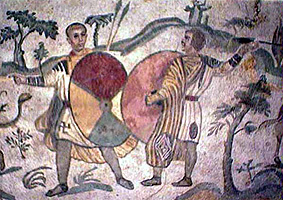
|
It is true that the shield patterns shown above do not seem to correspond exactly to any of those illustrated in the Notitia. However, this is perhaps not so surprising given that the Notita not only dates to nearly 100 years after the mosaic, but in between the two dates, the army had been substantially reorganised - including at the probable splitting of each unit in half and assigning one half, or possibly each half, entirely new shield patterns.
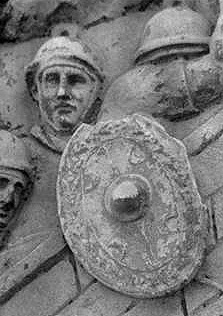
|
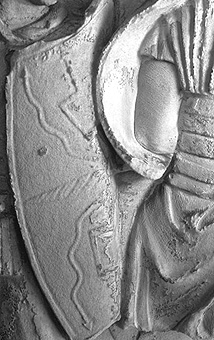
|
By way of comparison, above and to the left is a soldier from an auxiliary cohort carved on Trajan's column (erected in the 1st quarter of the 2nd century AD and therefore dating some 200 years earlier than the mosaic illustrations above) showing the typical wreath pattern. The closest parallel for this design in the Notitia would appear to be two ostrich heads arranged in a circular fashion on one of the 'Moorish' cavalry units' shields - ie. not very similar at all. To the right is a legionary's shield, also from Trajan's column, showing a typical thunderbolt device. Nothing like this is shown in the Notitia.
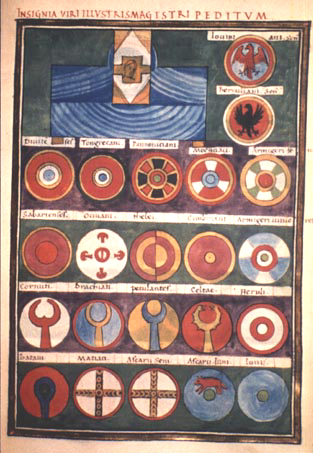
|
This is a page from one the Notitia copies, showing the senior
infantry units of the western half of the empire. They are drawn as
circles no doubt simply because hand-drawing dozens and dozens of
circles is much easier than drawing ovals - you can use a compass for
one thing! All the other pictorial evidence points to oval shields
for the majority, if not all of troops.
In general terms, the designs in the Notitia are less intricate than those from the early Principate, often being just simple blocks of colour. The similarity to those shown in the Piazza Armerina mosaics is quite obvious. For many other examples, see my Notitia Dignitatum shield patterns page. Exactly when shield patterns of this general style were introduced is unknown. From the Piazza Armerina mosaics we can see that they were obviously already in use by the time Constantine formalised the final creation of the mobile army, the comitatus (special officers for the force are only attested around the time of his death in 337 AD); their usage therefore seemingly dates back to the 3rd century, or possibly the late 2nd. Possible dates of significance are Gallienus' creation of a mobile reserve force based in Mediolanum (Milan) in the 250s AD, and the creation of the Tetrarchic system under Diocletian, in the years following 284 AD. As Gallienus does not seem to have created new units on the scale that Diocletian and his co-rulers did however, the late 280s AD might seem more probable, especially since it is in Diocletain's time that the field force is first called the sacer comitatus (even if it was actually smaller than the previous field forces). Even if such shield patterns were first used in Gallienus' time, they are likely to have been considerably expanded by the Tetrachy. However, another possible date is the creation of Legio II Parthica, at the very end of the 2nd century AD. This was the first legion 'permanently' stationed near Rome, and thus the original 'central reserve' force from which all others grew. Tombstones from members of this legion, from when it was later stationed in Apamea in Syria a few decades later, do not show any elaborate decoration (see J.C.Balty's "Apamea in Syrian in the Second and Third Centuries A.D." in the Journal of Roman Studies, 78 (1988), 91-104). This may have more to do with the crudity of the representations than any factual basis, but one shield's surface clearly shows a simple cross. If this is not interpreted as a cruciform shield bracing (and such strengthening on the outside of the shield would be unique for a Roman shield), then this would appear to be the first instance of a simple Notitia-style shield pattern on a Roman shield.
|
But did that mean the existing units kept their old shield designs? By the time of the Notitia, we can see that large units like the old legions had been split into a number of smaller fragments, each with its own (seemingly unrelated?) shield pattern, so at some stage the old units were given new shield patterns. This seems to have happened before the splitting of some of the Notitia units into seniores/iuniores, since we are told by Zosimus that the legions of the Herculiani and Joviani were each 6000 strong under the Tetrarchs, while their strength after being split into iuniores/seniores seems to have been considerably less to judge from Ammianus, even after accounting for the fact there were now two of each regiment. This implies they had already been fragmented into other units - each with presumably different shield patterns, before any iuniores/seniores split.
The Notitia only records the shield patterns of units in the field armies, so those units purely limited to garrison roles - including the old cohorts dating back to the 3rd century or before - are missing. However, as some garrison units are recorded as being temporarily part of the field armies ("pseudocomitatenses") a few of their shield patterns are recorded: they look just like other units in the Notitia and do not bear the old-style wreathes or thunderbolts. Since it is most improbable that units so promoted would be given new shield patterns for the occasion (the occassion, after all, being an emergency), one must conclude that they had their old shield patterns replaced at some time before. The question is when? It seems impossible the entire Roman army would replace every single one of its shields in one go at one date, so the most likely date is whenever each unit concerned was first 'finally' split. As these splittings seem to post-date Diocletian, perhaps we can attribute them to Constantine and the final formal organisation of the comitatus.
But if that is the case, then the Piazza Armerina soldiers must all belong to new units founded (or split off from their parents) in the third century rather than old units existing back into the time of old-style shield patterns. A clue may lie in the weapons carried by the soldiers. These do not seem to be a heavy throwing spear like the pilum, and they are too large for the darts, martiobarbuli, that legions of this period were known to have used. They appear to be lancea, a type of spear that could be both thrust or thrown (longche in Greek; the weapons Arrian described Roman cavalry as carrying in the 2nd century AD). These men might therefore be lanciarii (also spelled lancearii), if as seems likely, lanciarii used lancea. Lanciarii are seemingly attested, albeit infrequently, before the Tetrarchy, but become much more frequent during this period, and are I believe, members of the sacer comitatus (see here for an extended discussion).
I would suggest therefore that in the 3rd century AD, Roman shield patterns were a mixture of 2nd and 4th-century styles, rather than there being a sharp dividing line between the two. Newly created units, often those belonging to the Imperial reserve forces would use 4th-century styles, while other units would continue using the older styles until the 4th century. This would have the effect that during the 3rd century, the most elite units would have the plainest shield patterns, but this is not as strange as it initially sounds. Garrison units were the most likely to be uniformly equipped in many ways in that they were always stationed in one place, and drew their surplies from one source; field army units constantly on the move had to make do with equipment procured from a variety of sources. Shields would be no exception, and indeed, in as much as a shield is an expendable item, designed to be hacked apart by the enemy instead of its bearer being given the same treatment, the more likely it was to see action, the less likely it was to have much extra embellishment devoted to it. Evidence for this comes from comparing the extremely elaborately decoratied 3rd century shields discovered at Dura Europas, and seemingly belonging to auxiliary garrison units, with the simple cross depicted at Apamea for Legio II Parthica, and also the relatively simple shield patterns depicted in the bathhouse at Alba outside Rome and also usually considered to be associated with Legio II Parthica, two examples of which can be seen depicted by G.Sumner in P.Holder's article "Legio II Parthica: a Third Century Legion", Military Illustrated, 48 (1992), 18-23.

Return to my Ancient Military History index page.